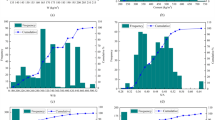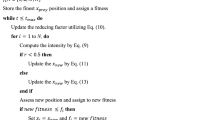Abstract
This paper presents machine learning algorithms based on back-propagation neural network (BPNN) that employs sequential feature selection (SFS) for predicting the compressive strength of ultra-high-performance concrete (UHPC). A database, containing 110 points and eight material constituents, was collected from the literature for the development of models using machine learning techniques. The BPNN and SFS were used interchangeably to identify the relevant features that contributed with the response variable. As a result, the BPNN with the selected features was able to interpret more accurate results (r2 = 0.991) than the model with all the features (r2 = 0.816). It is concluded that the usage of ANN with SFS provided an improvement to the prediction model’s accuracy, making it a viable tool for machine learning approaches in civil engineering case studies.
Access this chapter
Tax calculation will be finalised at checkout
Purchases are for personal use only
Similar content being viewed by others
References
S. Haykin, Neural Networks: A Comprehensive Foundation, 2nd edn. (Prentice Hall PTR, Upper Saddle River, 1998)
I. Flood, N. Kartam, Artificial Neural Networks for Civil Engineers: Advanced Features and Applications (American Society of Civil Engineers, New York, 1998)
J.A. Abdalla, M.F. Attom, R. Hawileh, Prediction of minimum factor of safety against slope failure in clayey soils using artificial neural network. Environ. Earth Sci. 73(9), 5463–5477 (2015)
J.A. Abdalla, M. Attom, R. Hawileh, Artificial neural network prediction of factor of safety of slope stability of soils, in The 14th International Conference on Computing in Civil and Building Engineering (Available at Moscow, Russia, 2012) pp. 27–29
L. Bal, F. Buyle-Bodin, Artificial neural network for predicting creep of concrete. Neural Comput. Appl. 25(6), 1359–1367 (2014)
J.A. Abdalla, R. Hawileh, Modeling and simulation of low-cycle fatigue life of steel reinforcing bars using artificial neural network. J. Franklin Inst. 348(7), 1393–1403 (2011)
J.A. Abdalla, R.A. Hawileh, Artificial neural network predictions of fatigue life of steel bars based on hysteretic energy. J. Comput. Civ. Eng. 27(5), 489–496 (2013)
J. Abdalla, R. Hawileh, Energy-based predictions of number of reversals to fatigue failure of steel bars using artificial neural network, in The 13th International Conference on Computing in Civil and Building Engineering (2010)
J.A. Abdalla, A. Elsanosi, A. Abdelwahab, Modeling and simulation of shear resistance of R/C beams using artificial neural network. J. Franklin Inst. 344(5), 741–756 (2007)
J.A. Abdalla, A. Abdelwahab, A. Sanousi, Prediction of shear strength of reinforced concrete beams using artificial neural network, in The First International Conference on Modeling, Simulation and Applied Optimization (Sharjah, U.A.E., 2005)
H.M. Tanarslan, M. Secer, A. Kumanlioglu, An approach for estimating the capacity of RC beams strengthened in shear with FRP reinforcements using artificial neural networks. Constr. Build. Mater. 30, 556–568 (2012)
J.A. Abdalla, R. Hawileh, A. Al-Tamimi, Prediction of FRP-concrete ultimate bond strength using artificial neural network, in International Conference on Modeling, Simulation and Applied Optimization (ICMSAO) (Kuala Lumpur, Malaysia, 2011)
J.A. Abdalla, E.I. Saqan, R.A. Hawileh, Optimum seismic design of unbonded post-tensioned precast concrete walls using ANN. Comput. Concr. 13(4), 547–567 (2014)
F. Deng, Y. He, S. Zhou, Y. Yu, H. Cheng, X. Wu, Compressive strength prediction of recycled concrete based on deep learning. Constr. Build. Mater. 175, 562–569 (2018)
H. Naderpour, A.H. Rafiean, P. Fakharian, Compressive strength prediction of environmentally friendly concrete using artificial neural networks. J. Build. Eng. 16(January), 213–219 (2018)
A. Heidari, M. Hashempour, D. Tavakoli, Using of backpropagation neural network in estimating of compressive strength of waste concrete. 1, 54–64 (2017)
R. Gupta, M.A. Kewalramani, A. Goel, Prediction of concrete strength using neural-expert system. J. Mater. Civ. Eng. 18(3), 462–466 (2006)
S.C. Lee, Prediction of concrete strength using artificial neural networks. Eng. Struct. 25(7), 849–857 (2003)
E. Ghafari, M. Bandarabadi, H. Costa, E. Júlio, Prediction of fresh and hardened state properties of UHPC : comparative study of statistical mixture design and an artificial neural network model. 27(11), 1–11 (2015)
G. Tayfur, T.K. Erdem, K. Önder, Strength prediction of high-strength concrete by fuzzy logic and artificial neural networks. J. Mater. Civ. Eng. 26(11), 1–7 (2014)
A. Torre, F. Garcia, I. Moromi, P. Espinoza, L. Acuña, Prediction of compression strength of high performance concrete using artificial neural networks, in VII International Congress of Engineering Physics, Journal of Physics: Conference Series, p. 582 (2015)
A.E. Naaman, K. Wille, G.J. Parra-Montesinos, Ultra-high performance concrete with compressive strength exceeding 150 MPa (22 ksi): a simpler way. Mater. J. 108(1)
Y.W.W. Zheng, B. Luo, Compressive and tensile properties of reactive powder concrete with steel fibres at elevated temperatures. Constr. Build. Mater. 41, 844–851 (2013)
K.-Q. Yu, J.-T. Yu, J.-G. Dai, Z.-D. Lu, S.P. Shah, Development of ultra-high performance engineered cementitious composites using polyethylene (PE) fibers. Constr. Build. Mater. 158, 217–227 (2018)
S. Abbas, M.L. Nehdi, M.A. Saleem, Ultra-high performance concrete: mechanical performance, durability, sustainability and implementation challenges. Int. J. Concr. Struct. Mater. 10(3), 271–295 (2016)
N. Soliman, A. Tagnit-Hamou, Using glass sand as an alternative for quartz sand in UHPC. 145 (2017)
N. Gu, M. Fan, L. Du, D. Ren, Efficient sequential feature selection based on adaptive eigenspace model. Neurocomputing 161, 199–209 (2015)
R. Kohavi, G.H. John, Wrappers for feature subset selection. Artif. Intell. 97(1–2), 273–324 (1997)
H. Zhou, M. You, L. Liu, C. Zhuang, Sequential data feature selection for human motion recognition via Markov blanket. Pattern Recognit. Lett. 86, 18–25 (2017)
V.F. Rodriguez-Galiano, J.A. Luque-Espinar, M. Chica-Olmo, M.P. Mendes, Feature selection approaches for predictive modelling of groundwater nitrate pollution: an evaluation of filters, embedded and wrapper methods. Sci. Total Environ. 624, 661–672 (2018), in S. Haykin (ed.), Neural Networks: A Comprehensive Foundation, 2nd edn. (Prentice Hall PTR, Upper Saddle River, 1998)
Author information
Authors and Affiliations
Corresponding author
Editor information
Editors and Affiliations
Rights and permissions
Copyright information
© 2021 Springer Nature Singapore Pte Ltd.
About this paper
Cite this paper
Choudhary, D., Keshari, J., Khan, I.A. (2021). Prediction of Compressive Strength of Ultra-High-Performance Concrete Using Machine Learning Algorithms—SFS and ANN. In: Gao, XZ., Tiwari, S., Trivedi, M., Mishra, K. (eds) Advances in Computational Intelligence and Communication Technology. Advances in Intelligent Systems and Computing, vol 1086. Springer, Singapore. https://doi.org/10.1007/978-981-15-1275-9_2
Download citation
DOI: https://doi.org/10.1007/978-981-15-1275-9_2
Published:
Publisher Name: Springer, Singapore
Print ISBN: 978-981-15-1274-2
Online ISBN: 978-981-15-1275-9
eBook Packages: Intelligent Technologies and RoboticsIntelligent Technologies and Robotics (R0)




